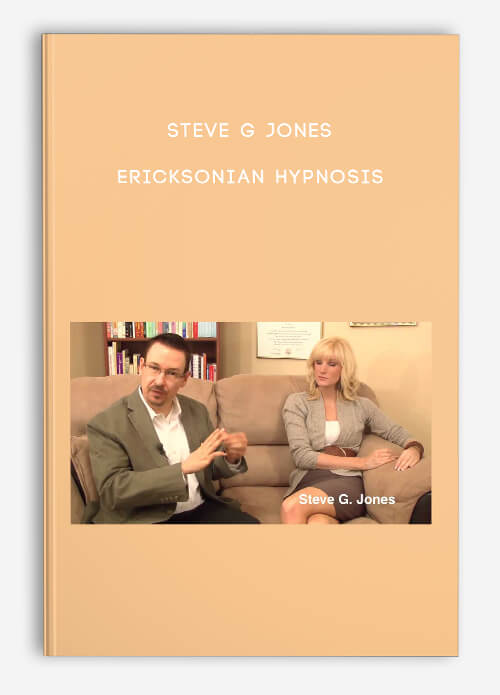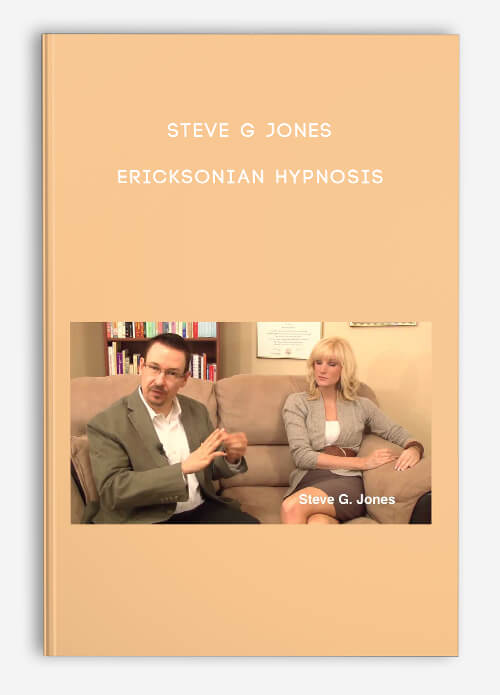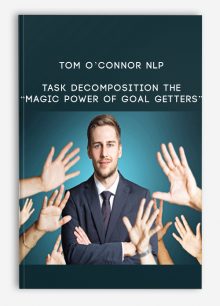Ericksonian Hypnosis by Steve G Jones
$147.00 $35.00
Product Include:
File size:
Ericksonian Hypnosis by Steve G Jones
**More information:
Get Ericksonian Hypnosis by Steve G Jones at Salaedu.com
Description
Module 1
Hypnosis in Medicine and Dentistry – Learn about the similarities between hypnosis and the practices used in medicine and dentistry.
Module 2
Hypnotic Rapport Building – Learn how to build the rapport needed to have your client trust and listen to you.
Module 3
Creating Sessions for People with Special Medical Needs – Learn how to structure therapy for those with special needs.
Module 4
Dealing with Medical Treatments – Learn the most effective ways to begin treatment with clients.
Module 5
Arm Raise Induction – Learn a special technique that helps to easily relax the client before treatment.
Module 6
Bucket Lowering Induction – Learn another unique induction technique for relaxation.
Module 7
Balloon Raise Induction – This technique helps those with uncontrollable body movements stay relaxed and calm.
Module 8
Proper Office Design to Enhance Rapport – Learn how to make your office’s design conducive to a hypnosis session and long conversations as the physical space within your office is an extension of who you are and what you represent as a hypnotherapist.
Module 9
Being Adaptive as a Hypnotist To Any Client Situation – This module shows you how to position yourself as a powerful individual who has the ability to communicate what needs to be said even in the toughest of situations.
Module 10
How to Tap Into your Genuine Desire to Help People – Here you’ll learn the steps needed to provide the most value and help as possible to your clients during sessions.
Module 11
Paying Attention to Client Feedback to Improve your Sessions – Learn how to discover how the client would like to talk and adapt to his own mode of communication so you can create and convey meaning more effectively.
Module 12
Pacing and Leading – Learn to identify key elements used by both speaker and listener to keep the interaction going.
Module 13
Eye-Accessing Cues – Learn how to effectively understand what the clients in thinking by reading his/her eye movements.
Module 14
Anchoring – Learn the process of encouraging a specific reaction from another person when a pre-associated stimulus is manifested.
Module 15
The Uniqueness of Each Client – Learn the idea of maximal utilization and how to take advantage of the fact that people are unique and therefore, each treatment should be different to get the best possible result.
Module 16
The Meta-Model – Learn about the Meta Model, which bears a close resemblance to the list of ten “cognitive distortions” found in Cognitive- Behavioral Therapy and identifies common language patterns and hampers first-class communication.
Module 17
Model Limits – Learn about the ways that a person constrains himself as a functioning member of society.
Module 18
Creating Metaphors – Learn how to about effective tools in conveying valuable insight and messages to hypnotic clients.
Module 19
How to Use Metaphors in a Hypnosis Session – Learn the most effective technique for metaphor usage during hypnosis.
Module 20
The Use of Parallelisms in Metaphor Creation – Learn a four step process that creates the perfect metaphor for hypnotic clients.
Hypnosis coures
Hypnosis is a human condition involving focused attention, reduced peripheral awareness, and an enhanced capacity to respond to suggestiom.
There are competing theories explaining hypnosis and related phenomena.
Altered state theories see hypnosis as an altered state of mind or trance, marked by a level of awareness different from the ordinary state of consciousness.
In contrast, nonstate theories see hypnosis as, variously, a type of placebo effect, a redefinition of an interaction with a therapist or form of imaginative role enactment.
During hypnosis, a person is said to have heightened focus and concentration.
Hypnotized subjects are said to show an increased response to suggestions.
Hypnosis usually begins with a hypnotic induction involving a series of preliminary instructions and suggestion.
The use of hypnotism for therapeutic purposes is referred to as “hypnotherapy”, while its use as a form of entertainment for an audience is known as “stage hypnosis”.
Stage hypnosis is often performed by mentalists practicing the art form of mentalism.
1 review for Ericksonian Hypnosis by Steve G Jones
Add a review Cancel reply
Related products
HYPNOSIS - NLP Courses
HYPNOSIS - NLP Courses
Christina Hall – The Paradoxical Nature of Change – Video Book
HYPNOSIS - NLP Courses
Tom O’Connor NLP – Task Decomposition The “Magic Power of Goal Getters”
HYPNOSIS - NLP Courses
HYPNOSIS - NLP Courses
Niraj Naik – Renew Your Body & Reprogram Your Reality With SOMA Breathwork
HYPNOSIS - NLP Courses











king –
We encourage you to check Content Proof carefully before paying.“Excepted” these contents: “Online coaching, Software, Facebook group, Skype and Email support from Author.”If you have enough money and feel good. We encourage you to buy this product from the original Author to get full other “Excepted” contents from them.Thank you!